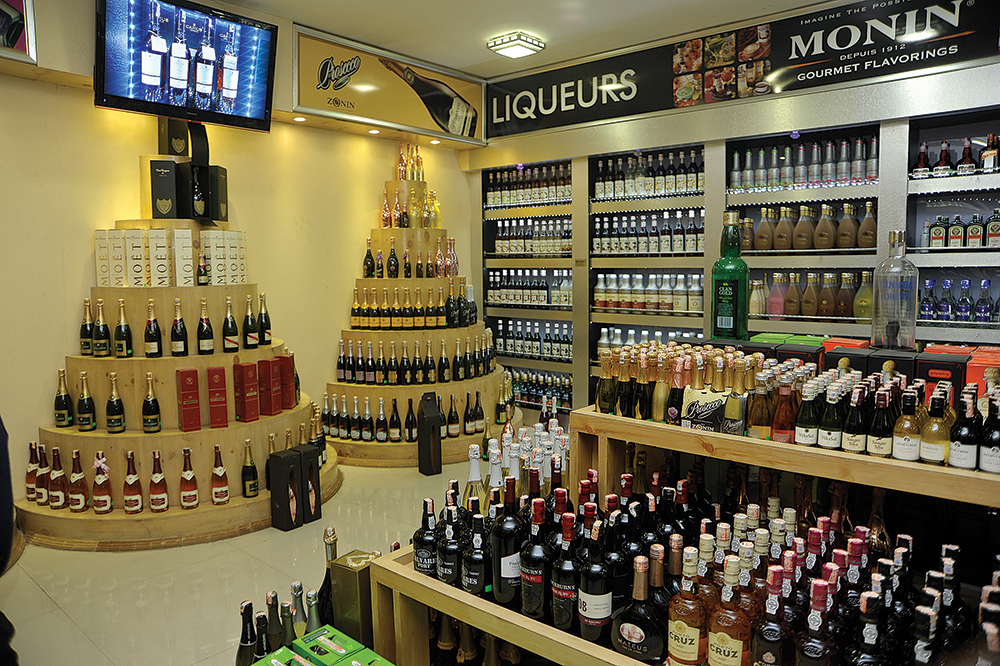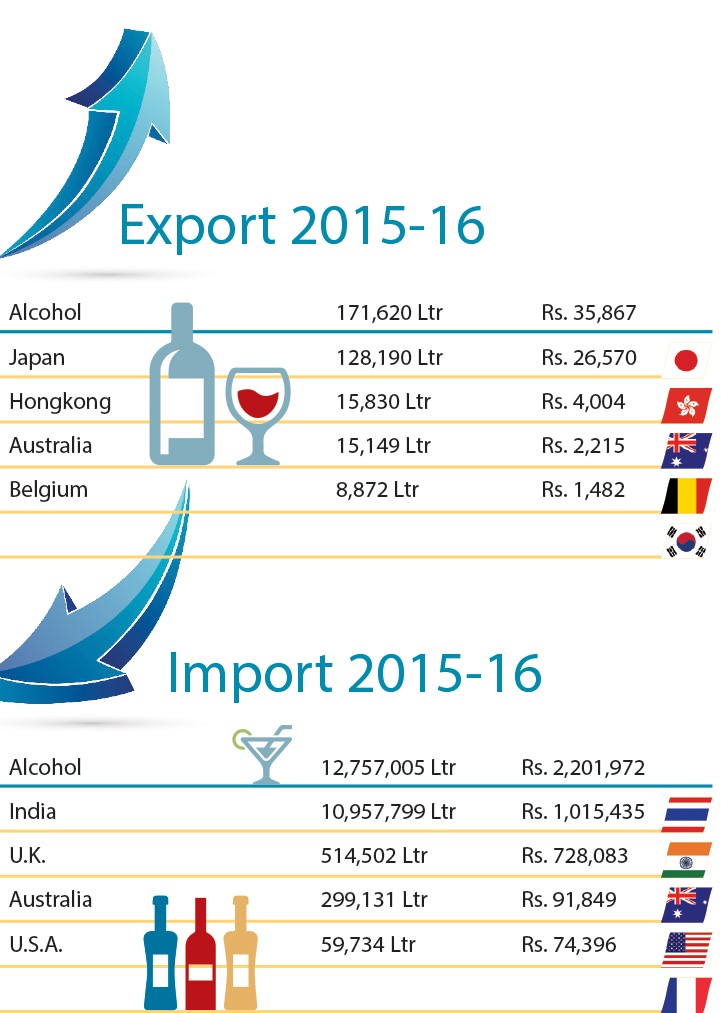
Annual consumption of the domestic liquor is as high as Rs 85 billion. Kathmandu alone consumes as much as 45 percent of total liquor that the country produces and imports.
Gaurav Sharda, Managing Director of SPG Trading, the authorised distributor of famous French company, Pernod Ricard observes that the market has matured like never before. “Even though it’s still evolving, consumers have matured in terms of what they want to buy and what not,” he shares, “They have understood what are the good products and what not, while they are also ready to pay for premium brands.”
In line with Sharda’s observation, other industry insiders claim that consumers are really precise when it comes to taste and quality. “Surprisingly, buyers these days are particular about what they want and you can’t impel them to buy this or that. No matter what, they remain loyal to their taste and brand,” says Abhisek Agrawal, Managing Director of Greenline Centre, an exclusive showroom of imported range of premium brands in wine, whiskey, liquor, cigarettes and cigars. He reflects that just a few years ago, customers would approach the store and ask for advice before choosing a brand. Greenline deals with about 800 stock keeping units (SKUs) of liquors, wines and other related products while it records a revenue of Rs 500 million annually.
Industrialists claim the liquor market is growing both qualitatively and quantitatively. According to Nepal Beverage and Cigarettes Industries Association (NBCIA), beverage has been one of the Nepal’s largest industry segments and holds big prospects. “Manufacturers are doing great business, consumers are offered with multiple choices and the state coffer is benefitted from ever growing revenue,” Ramesh Shrestha, President of the NBCIA opines, “It’s a win-win situation for all.”
According to him, as much as Rs 20 billion has been invested in Nepal’s domestic liquor industry (includes only those which have been legally registered). It takes approximately Rs 150 million rupees for a new liquor plant to be established. NBCIA figures estimate that approximately 30,000 individuals are directly employed in this sector while indirect employment stands at quadruple units. “Taxes stand at Rs 50 billion per annum on average including Rs 10 billion in VAT (value added tax) only,” claims Shrestha estimating that the annual consumption of the domestic liquor is as high as Rs 85 billion.

Statistics availed from the Department of Industry (DoI) states that a total of 83 liquor companies have been registered so far committing total capital of Rs 14.58 billion. The Department, however, only entertains the registration of any industry that has total working capital of more than Rs 30 million. The NBCIA also estimates that the beverage industry has been growing by around 20 percent annually for the last five years.
Aditya Agrawal, Director, Business Development for Global Trading, one of the largest importers in Nepal which deals with beverages from Diageo, observes that the premium segment of liquor market is growing and that even in the domestic landscape, the production and consumption of premium segments of beverages is shooting up. “Alcohol has been very common to Nepali lifestyle and people do not feel awkward to consume openly even in the formal settings,” he says, “This is the reason why different brands are coming to Nepal because the acceptance level is very high.”
According to athe Economic Survey 2015-16 published by the Central Bank, the consumption of hard drinks increased by 20.1 percent in the fiscal year 2014-15 while price index rose by 14.5 percent. Kathmandu alone consumes as much as 45 percent of total liquor that the country produces and imports. Other cities where consumption is on the rise include Pokhara, Chitwan, Butwal, Birgunj, Biratnagar and Dharan.
Foreign liquor companies that have been producing liquor in Nepal to not carry more than six percent of the total annual profit back to their country of origin.

Despite the steady growth in demand, things are not alright. In September 2016, The Kathmandu Post published the news in which two favoured brands - Blenders Pride and Royal Stag - left Nepal after a rift with the government. Himalayan Distillery had been producing these products in collaboration with the French multinational, Pernod Ricard. The company however decided to leave Nepal following a FDI unfriendly directive from the government according to which multinationals that have been producing their products in Nepal in collaboration with local partners can take back only six percent of their annual profit. “It takes years for a brand to establish while the company has to invest millions of rupees for the same. And when they are able to make profit they have the cap of only six percent for the same,” says a manufacturer requesting anonymity.
The manufacturer also shared that his request to few Indian liquor makers to get production approval from them went in vain due to capping provision in the profit-taking. “Foreign players are skeptical about the Nepali market,” he says adding, “The cap on profits that can be taken back home has been the biggest problem of late”.
DoI last year introduced a directive intending to safeguard and promote local alcohol industries. The directive that came into effect from September 18, 2015 made it mandatory for foreign liquor companies that have been producing liquor in Nepal to not to carry more than six percent of the total annual profit back to their country of origin. Maheshwor Neupane, Director General of the Department said that the provision was introduced to promote local industries, “We already have many liquor producers here, we do not think that we need foreign companies in Nepal to produce their beverages.” Even though the DoI expects the local industry to flourish, it has stopped providing licence to new players who want to invest in the liquor industry.
While questioning about the thick presence of foreign brands in the Nepali market, Sharda answers, “The brands have not come here by their own will. It’s us who have brought them here,” hinting that the market for premium brands is not as enticing as seen on the surface. Agrawal of Global Trading, on the other hand says, “Yes there are a lot of premium global brands here in the market but we also need to understand the difference between availability and selling. Only being available and not selling is pointless.”
Sharda complains that the duty on import of liquor has been another area of trouble that might in the near future contribute to discouraging the entire industry. “We have to pay flat Rs 2,200 per liter while importing any kind of alcohol,” he adds, “This will eventually encourage buyers to postpone their buying as they can’t afford liquor that are priced abnormally high due to the massive duty.” Industrialists who agree with Sharda says such a high duty will foster illegal trading of liquor from India through the porous border as a majority of brands are sold at cheaper rates in India.
Agrawal of Global Trading says the year on year growth of the liquor market is satisfactory and adds, “It could have been even better had political and economic stability been ensured.” He also puts in that, in this sense, the market is missing out on opportunity.

Nepal imports 12,757,005 liters of foreign liquors worth Rs 2.20 billion.
Local manufacturers blame the government for stopping licenses to establish liquor factories or permitting to upgrade their capacity and promoting imports. There are others who claim that even if Nepal produces enough volume of liquor, it is something that a country can never really be self reliant in. “It’s not about the amount that we produce, but it’s about the taste and quality,” says Shrestha, President of NBCIA, “The imports will never stop because people want new taste with premium quality.”
Importers claim that the imported spirits have never been a problem for local manufacturers. “There has never been any competition between the locally produced and imported liquors,” Agrawal of Global Trading says, adding, “Both have their own market and target customers, while the vast difference in the price also never allows competition.”
K.K. Churiwala, General Manager of Nepal Distilleries opines that the entry of foreign brands has given people more choices. “The country has immense potential and traders are very positive about the market,” he says, adding “Such has been the competition that only the best of the products can make space for themselves while cheaper and low standard products have already been displaced”.
According to Trade and Export Promotion Center (TEPC), Nepal imported 12,757,005 liters of foreign liquors worth Rs 2.20 billion. Traders estimate that the growth in the import of foreign liquor is swelling up by 10 percent every year.
Of the total annual consumption of the liquor, only five percent products sold are foreign brands while 95 percent constitute those manufactured within the country. According to traders only around 8000 cases of foreign liquors are sold in Nepali market in a month.
Agrawal of Greenline says that the competition in the liquor industry has become tough. “The arrival of new products and rapid expansion of liquor outlet shows that the sector holds prospect yet the competition is cut-throat,” he adds.
The price of foreign liquor varies starting from Rs 2,000 to Rs 300,000 a liter. Nabin Sijapati, Marketing Manager of Yeti Distillery says that the most expensive liquors produced domestically are those manufactured by his company. “Old Durbar Black Chimney Whiskey costs Rs 2,590 for 750ml and is the most expensive domestic whiskey,” he claims.
Nepal in the fiscal year 2015-16 exported 171,620 liters of alcohol worth Rs 35 million.
It’s not only just that Nepal imports spirits in billions, the country’s premium quality liquors are finding place in the global marketplace. Nepal Distilleries, the oldest liquor manufacturer of the country, is a giant in exports and the first to take its product to the global market. “We are exporting Coronation Khukri Rum since 2001,” Churiwala says, “Such has been the like for our product that in 2002 Khukri Rum bagged an award at the Rum Festival in Canada and in 2003 in Sharjah.” The company is the largest rum maker in the country with 95 percent market share in its segment. It offers Khukri XXX Rum, Coronation Khukri Rum and Khukri Spice Rum.”Over time, these names have become synonymous with the fine quality rum in not just Nepal but also in several parts of the world,” elaborates Churiwala. The company has been shipping its products in 20 countries includin, Dubai, USA, UK, Japan, Lebanon, Italy, Hong Kong, Korea, Australia and Germany and will be adding new destinations in the years to come.
Old Durbar Black Chimney Whiskey, 8848 Vodka, Hinwa Wine, Divine Wine and Dandaghare Wine are other brands that have found export market. Nepal in the fiscal year 2015-16 exported 171,620 liters of alcohol worth Rs 35 million.






